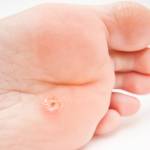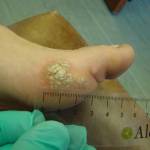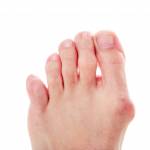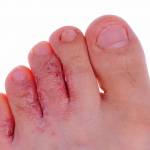Common Foot Ailments
The Human Foot
The human foot is a strong and complex mechanical structure containing 26 bones and 33 joints, including the ankle joint and the interphalangeal joints, found between the bones of the toes. The human foot is formed of more than a hundred muscles, tendons, and ligaments
Feet are in constant use and are often subject to considerable strain which may cause injury. What we choose to wear on our feet, how we choose to bathe them and many of our day to day activites all play a vital role in the care of our feet.
Listed are some common foot ailments, what causes these foot ailments and how we can cure and even prevent them.
Corns & Callouses
 Corns and callouses are areas of thickened skin that can be painful. They are caused by continued and excessive friction (rubbing) and pressure. These are a symptom, not a disease, they do not have roots. The cause must be corrected before the corns and callouses can be cured. Chronic corns and callouses require periodic professional care. However, in some instances, surgical or orthopaedic measures may be required.
Corns and callouses are areas of thickened skin that can be painful. They are caused by continued and excessive friction (rubbing) and pressure. These are a symptom, not a disease, they do not have roots. The cause must be corrected before the corns and callouses can be cured. Chronic corns and callouses require periodic professional care. However, in some instances, surgical or orthopaedic measures may be required.
Under no circumstances should home treatment be attempted. This may lead to foot infections which can be very serious.
Verrucae
 Verrucae are plantar warts. They are caused by the Human Papilloma Virus (HPV) and are often wrongly mistaken for corns or callouses. A Verruca has a blood and nerve supply of its own and is identifiable through its white appearance with distinguishing black dots. Verracue are contagious and are usually painful particularly when present on a weight bearing part of the foot. Verrucae can spread if left untreated.
Verrucae are plantar warts. They are caused by the Human Papilloma Virus (HPV) and are often wrongly mistaken for corns or callouses. A Verruca has a blood and nerve supply of its own and is identifiable through its white appearance with distinguishing black dots. Verracue are contagious and are usually painful particularly when present on a weight bearing part of the foot. Verrucae can spread if left untreated.
Excessive Perspiration
This can cause foot odour. Daily bathing and regular application of a medicated foot powder can help in many cases. When these fail, you should visit a Chiropodist for professional advice.
Bunions (hallux valgus)
 Bunions are caused by a weakness of the ligamentous and muscular structures of the foot and leg. The tendency for them to form may be hereditary, but factors such as stress and strain and interference from shoes can also bring about this deformity. When these joints are red, swollen or tender, see a Chiropodist, as these signs may indicate the formation of a bunion, arthritis, gout or infection. A bunion on the joint of the little toe is known as a tailor’s bunion.
Bunions are caused by a weakness of the ligamentous and muscular structures of the foot and leg. The tendency for them to form may be hereditary, but factors such as stress and strain and interference from shoes can also bring about this deformity. When these joints are red, swollen or tender, see a Chiropodist, as these signs may indicate the formation of a bunion, arthritis, gout or infection. A bunion on the joint of the little toe is known as a tailor’s bunion.
Athlete’s Foot
 This is a skin disease caused by a fungus known as tinea fungus. The main cause of athlete’s foot is the lowering of the skin’s resistance. This fungus thrives in warm, dark and sometimes moist environments such as inside the shoe, swimming pool edges, showers etc. It is possible to catch the fungus through direct contact with another infected person or by touching surfaces contaminated with the fungus.
This is a skin disease caused by a fungus known as tinea fungus. The main cause of athlete’s foot is the lowering of the skin’s resistance. This fungus thrives in warm, dark and sometimes moist environments such as inside the shoe, swimming pool edges, showers etc. It is possible to catch the fungus through direct contact with another infected person or by touching surfaces contaminated with the fungus.
Practice good foot hygiene! The skin must be bathed daily; be kept dry by changing socks or tights frequently; and a mild fungicidal drying powder used on the feet and in the shoes.
